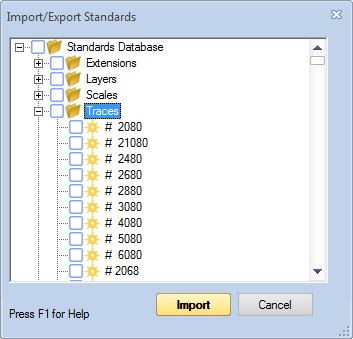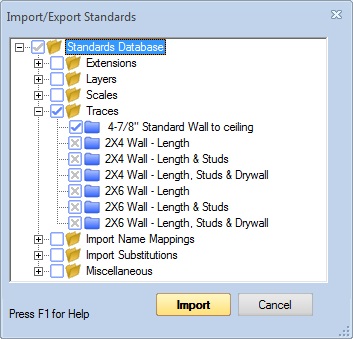Standards Importing Window
Standards include all the information that is used across multiple projects. In includes:
- Standard Bid Codes
- Standard Extensions
- Standard Layers
- Standard Scales
- Standard Traces
- Standard Import Name Mappings
- Standard Import Text Substitutions
- Custom Point Symbols
- Miscellaneous - this may include any of the following:
- Extension variables used as columns in the Measurement List
- Measurement List Column Configurations
- Quantity Worksheet Column Configurations
- Standards Security Setup
Exporting and Importing standards allows users within an organization to share a common set of standards. It also allows Dimension to distribute commonly used standards. One user can Export Standards to a file. This file can then be sent to other users who can Import the Standards as described below.
Standard Importing is invoked by clicking on the Ribbon Bar Settings Tab / Import Standards button. A standard Windows File Dialog will be displayed, allowing you to select the file you wish to import. Select the file and press the "Open" button. The standards information from the file will displayed in the the Standards Import Selection Window.

Figure 1: Standards Import Selection Window
Most of the window is filled with the selection tree. The tree has tree levels:
- The "Standards Database" branch containing all standards.
- The type container branches for Bid Codes, Extensions, Layers, Traces, Scales, Point Symbols, Name Mappings and Substitutions.
- The individual Bid Codes, Extensions, etc. that were found in the import file.
If you organize your traces in a tree, that tree will appear below the Traces branch.
Initially nothing will be selected and the third level will not be shown. You can select or de-select a branch by clicking the check box just to the left of the folder icon name. Selecting or de-selecting a branch selects or de-selects all its member branches. Thus selecting the "Standards Database" branch will select all the Bid Codes, Extensions, Layers, Point Symbols, Scales and Traces in the entire import file.
Branches can be opened or closed by clicking on the +/- box to the left of the check box.
This checkboxes and the icons indicate the status of the branch:
 A folder branch NONE
of whose members are checked. Click on the check box to select all members.
A folder branch NONE
of whose members are checked. Click on the check box to select all members. A folder branch ALL
of whose members are checked. Click on the check box to de-select all members.
A folder branch ALL
of whose members are checked. Click on the check box to de-select all members. A folder branch SOME
of whose members are checked. Click on the check box to select all members.
A folder branch SOME
of whose members are checked. Click on the check box to select all members. A standard branch which
is NOT currently in the standards database but is NOT selected for import.
Click on the check box to select the standard.
A standard branch which
is NOT currently in the standards database but is NOT selected for import.
Click on the check box to select the standard. A standard branch which
is NOT currently in the standards database and IS selected for import.
Click on the check box to de-select the standard.
A standard branch which
is NOT currently in the standards database and IS selected for import.
Click on the check box to de-select the standard. A standard branch which
IS currently in the standards database. The import standard is
identical to the existing standard. It will not be re-imported.
A standard branch which
IS currently in the standards database. The import standard is
identical to the existing standard. It will not be re-imported. A standard branch which
IS currently in the standards database but the import standard is
different than the existing standard. It is NOT selected for import.
Click on the check box to select the standard.
A standard branch which
IS currently in the standards database but the import standard is
different than the existing standard. It is NOT selected for import.
Click on the check box to select the standard. A standard branch which
IS currently in the standards database but the import standard is
different than the existing standard. It IS selected for import.
Click on the check box to de-select the standard.
A standard branch which
IS currently in the standards database but the import standard is
different than the existing standard. It IS selected for import.
Click on the check box to de-select the standard. A standard branch which
must be imported. It is selected for import and can't be de-selected.
This is used to import Standards Security Setup.
A standard branch which
must be imported. It is selected for import and can't be de-selected.
This is used to import Standards Security Setup.
At the third level, standards in the import file and ALREADY in the standards database will be displayed with a blue file icon and can't be selected for import. For extensions, there may be extensions that are already in the database with a different version in the import. These are shown with a blue file icon containing a checkbox. You may check these to have the import version overwrite the version in the database.

Figure 2: Selection Tree after Selecting and Opening
Once the desired standards have been selected, you can press the "Import" button to import them. The selected standards will be added to the standards database.
Note: If you import extension variables used as columns in the Measurement List, the changes will not take effect until the next time you open the Measurement List.
